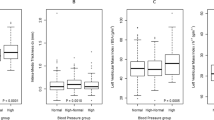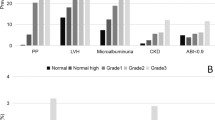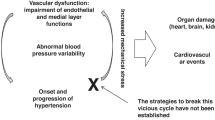Abstract
To evaluate the correlation between endothelial dysfunction and multiple target organ damage (TOD), we measured endothelial function using high-resolution ultrasonography in hypertensive patients with or without TOD. Two hundred and eighty patients with hypertension were divided into four groups as follows: no TOD (Group I, n=61); 1 TOD (Group II, n=113); 2 TOD (Group III, n=59); and ⩾3 TOD (Group IV, n=47). Endothelial function was assessed by endothelium-dependent flow-mediated dilatation (FMD) and -independent vasodilation (after sublingual administration of nitroglycerin) of the brachial artery using high-resolution vascular ultrasound. We also assessed the intima–media thickness (IMT) of the common carotid, carotid to femoral pulse wave velocity (cf-PWV) and left ventricular mass index (LVMI). FMD was inversely associated with the number of affected organs. FMD was lower in the patient groups with ⩾3 TOD (Group IV: 6.85±4.70% vs Group II: 10.00±6.15%, P<0.01), 2 TOD (Group III: 7.37±5.02% vs Group II, P<0.01) and 1 TOD as compared with patients with no TOD (Group I: 11.88±7.11% vs Group II, P<0.05). In univariate correlation analysis, there was a significant relationship between FMD and IMT, serum creatinine, LVMI and cf-PWV. In stepwise multivariate regression analysis, FMD still correlated with waist size (β=−0.283, P<0.01), age (β=−0.231, P<0.05) and IMT (β=−0.197, P=0.05). These findings suggested that reduced FMD was associated with the number of TOD and may be considered an indicator for evaluating TOD.
This is a preview of subscription content, access via your institution
Access options
Subscribe to this journal
Receive 12 digital issues and online access to articles
$119.00 per year
only $9.92 per issue
Buy this article
- Purchase on Springer Link
- Instant access to full article PDF
Prices may be subject to local taxes which are calculated during checkout






Similar content being viewed by others
References
Verdecchia P, Carini G, Circo A, Dovellini E, Giovannini E, Lombardo M et al. Left ventricular mass and cardiovascular morbidity in essential hypertension: the MAVI study. J Am Coll Cardiol 2001; 38: 1829–1835.
O′Leary DH, Polak JF, Kronmal RA, Manolio TA, Burke GL, Wolfson Jr SK . Carotid-artery intima and media thickness as a risk factor for myocardial infarction and stroke in older adults. Cardiovascular Health Study Collaborative Research Group. N Engl J Med 1999; 340: 14–22.
Hillege HL, Fidler V, Diercks GF, van Gilst WH, de Zeeuw D, van Veldhuisen DJ et al. Urinary albumin excretion predicts cardiovascular and noncardiovascular mortality in general population. Circulation 2002; 106: 1777–1782.
Schillaci G, Reboldi G, Verdecchia P . High-normal serum creatinine concentration is a predictor of cardiovascular risk in essential hypertension. Arch Intern Med 2001; 161: 886–891.
Mancia G, De Backer G, Dominiczak A, Cifkova R, Fagard R, Germano G et al. 2007 Guidelines for the Management of Arterial Hypertension: The Task Force for the Management of Arterial Hypertension of the European Society of Hypertension (ESH) and of the European Society of Cardiology (ESC). J Hypertens 2007; 25: 1105–1187.
Celermajer DS, Sorensen KE, Gooch VM, Spiegelhalter DJ, Miller OI, Sullivan ID et al. Non-invasive detection of endothelial dysfunction in children and adults at risk of atherosclerosis. Lancet 1992; 340: 1111–1115.
Anderson TJ, Uehata A, Gerhard MD, Meredith IT, Knab S, Delagrange D et al. Close relation of endothelial function in the human coronary and peripheral circulations. J Am Coll Cardiol 1995; 26: 1235–1241.
Furumoto T, Saito N, Dong J, Mikami T, Fujii S, Kitabatake A . Association of cardiovascular risk factors and endothelial dysfunction in japanese hypertensive patients: implications for early atherosclerosis. Hypertens Res 2002; 25: 475–480.
Muiesan ML, Salvetti M, Monteduro C, Corbellini C, Guelfi D, Rizzoni D et al. Flow-mediated dilatation of the brachial artery and left ventricular geometry in hypertensive patients. J Hypertens 2001; 19: 641–647.
Ghiadoni L, Huang Y, Magagna A, Buralli S, Taddei S, Salvetti A . Effect of acute blood pressure reduction on endothelial function in the brachial artery of patients with essential hypertension. J Hypertens 2001; 19: 547–551.
Ghiadoni L, Versari D, Magagna A, Kardasz I, Plantinga Y, Giannarelli C et al. Ramipril dose-dependently increases nitric oxide availability in the radial artery of essential hypertension patients. J Hypertens 2007; 25: 361–366.
Modena MG, Bonetti L, Coppi F, Bursi F, Rossi R . Prognostic role of reversible endothelial dysfunction in hypertensive postmenopausal women. J Am Coll Cardiol 2002; 40: 505–510.
Corretti MC, Anderson TJ, Benjamin EJ, Celermajer D, Charbonneau F, Creager MA et al. Guidelines for the ultrasound assessment of endothelial-dependent flow-mediated vasodilation of the brachial artery: a report of the International Brachial Artery Reactivity Task Force. J Am Coll Cardiol 2002; 39: 257–265.
Asmar R, Benetos A, Topouchian J, Laurent P, Pannier B, Brisac AM et al. Assessment of arterial distensibility by automatic pulse wave velocity measurement. Validation and clinical application studies. Hypertension 1995; 26: 485–490.
Wolff B, Lodziewski S, Bollmann T, Opitz CF, Ewert R . Impaired peripheral endothelial function in severe idiopathic pulmonary hypertension correlates with the pulmonary vascular response to inhaled iloprost. Am Heart J 2007; 153: 1088. e1-7.
Panza JA, Quyyumi AA, Brush Jr JE, Epstein SE . Abnormal endothelium-dependent vascular relaxation in patients with essential hypertension. N Engl J Med 1990; 323: 22–27.
Yan RT, Anderson TJ, Charbonneau F, Title L, Verma S, Lonn E . Relationship between carotid artery intima–media thickness and brachial artery flow-mediated dilation in middle-aged healthy men. J Am Coll Cardiol 2005; 45: 1980–1986.
Yeboah J, Burke GL, Crouse JR, Herrington DM . Relationship between brachial flow-mediated dilation and carotid intima–media thickness in an elderly cohort: the Cardiovascular Health Study. Atherosclerosis 2008; 197: 840–845.
Benjamin EJ, Larson MG, Keyes MJ, Mitchell GF, Vasan RS, Keaney Jr JF et al. Clinical correlates and heritability of flow-mediated dilation in the community: the Framingham Heart Study. Circulation 2004; 109: 613–619.
Corrado E, Rizzo M, Coppola G, Muratori I, Carella M, Novo S . Endothelial dysfunction and carotid lesions are strong predictors of clinical events in patients with early stages of atherosclerosis: a 24-month follow-up study. Coron Artery Dis 2008; 19: 139–144.
Kobayashi K, Akishita M, Yu W, Hashimoto M, Ohni M, Toba K . Interrelationship between non-invasive measurements of atherosclerosis: flow-mediated dilation of brachial artery, carotid intima–media thickness and pulse wave velocity. Atherosclerosis 2004; 173: 13–18.
Lind L . Left ventricular mass is related to endothelium-dependent vasodilation in the forearm, but not in the brachial artery, in elderly subjects: the Prospective Investigation of the Vasculature in Uppsala Seniors study. J Hum Hypertens 2008; 22: 767–773.
Malik AR, Sultan S, Turner ST, Kullo IJ . Urinary albumin excretion is associated with impaired flow- and nitroglycerin-mediated brachial artery dilatation in hypertensive adults. J Hum Hypertens 2007; 21: 231–238.
Acknowledgements
This study was supported by National Natural Science Foundation of China (30670832 and 30870941), National Key Project for Basic Research (2004CB518603, 2006CB503804 and 2009CB521905), National High-tech R&D Program (2006AA02Z179) and a grant from the Shanghai Science and Technology Committee (08JC1417400, 08DZ2200400, 08410702400).
Author information
Authors and Affiliations
Corresponding author
Rights and permissions
About this article
Cite this article
Xu, JZ., Zhang, Y., Wu, SN. et al. Impaired endothelial function in hypertensive patients with target organ damage. J Hum Hypertens 23, 751–757 (2009). https://doi.org/10.1038/jhh.2009.10
Received:
Revised:
Accepted:
Published:
Issue Date:
DOI: https://doi.org/10.1038/jhh.2009.10
Keywords
This article is cited by
-
Left atrial diameter, flow-mediated dilation of brachial artery and target organ damage in Chinese patients with hypertension
Journal of Human Hypertension (2012)
-
Endothelial dysfunction in normotensive salt-sensitive subjects
Journal of Human Hypertension (2012)
-
Endothelial dysfunction and diurnal variation of blood pressure: night secrets of arterial hypertension?
Journal of Human Hypertension (2011)
-
Relationship of Insulin Resistance to Macro- and Microvasculature Reactivity in Hypertension
American Journal of Hypertension (2010)
-
Editors choice: recent highlights from the journal of human hypertension
Journal of Human Hypertension (2010)



